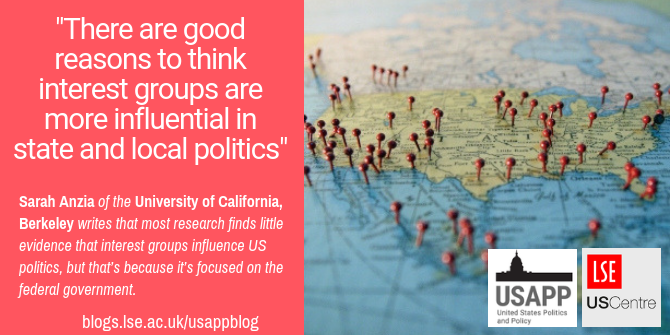 There is widespread belief that interest groups such as gun rights associations, unions, and environmental lobby groups have significant influence on US politics. But, writes Sarah F. Anzia, because of a close research focus on the federal level, there is actually little evidence that this is the case. She writes that studying groups’ influence in relation to local and state governments would give a much better picture of just how much influence interest groups actually have.
There is widespread belief that interest groups such as gun rights associations, unions, and environmental lobby groups have significant influence on US politics. But, writes Sarah F. Anzia, because of a close research focus on the federal level, there is actually little evidence that this is the case. She writes that studying groups’ influence in relation to local and state governments would give a much better picture of just how much influence interest groups actually have.
People who follow the politics of gun control, climate change, or public education in the United States might be surprised to learn that political science research finds little evidence that interest groups have influence on politics or public policy. As interest groups scholar Beth Leech puts it, “Almost everyone believes that interest groups are influential, and yet systematic studies have as often pointed to the limits on interest group influence as have concluded that strong influence exists.”
But there is a problem with how most researchers study interest groups: they focus almost exclusively on the federal government. Because of this national focus, basic questions have gone unasked, important types of interest groups have gone underappreciated, and the overall amount of interest group influence in the country has been underestimated. If researchers were to focus more on US state and local politics, they would discover rich variation in interest group activity, different constellations of interest groups, and a political context in which it is easier to see interest groups’ effects.
Consider US local governments—the tens of thousands of municipalities, counties, school districts, and special districts that provide essential public services. We don’t even really know how active interest groups are in such places or which are involved. We also don’t have any theories to help answer those questions, because studies of interest groups in Washington, DC, mostly just describe the kinds of groups that lobby in the nation’s capital. Studying subnational government would force researchers to think through some of these basic questions, such as when and where we should expect interest groups to be active in politics in general.
Why we need to study interest groups beyond the Beltway
It would also reveal that political science research today provides an incomplete picture of interest group activity in the country. After all, state and local governments focus on different issues than the federal government. That means that the sets of interest groups active in state and local politics should look different from those in Washington, DC.
Unions are a major case in point. American politics research gives the impression that private-sector unions are the sum total of the union movement and that unions are weak and in decline. Yet government employees are now a majority of union members in the US, and public-sector unions are major players in American politics. But interest groups researchers barely mention them. Why? In part because public-sector unions are much more active in state and local politics than in national politics.
The preoccupation with national government is also a reason why researchers have struggled to find clear evidence of interest group influence. There are good reasons to think interest groups are more influential in state and local politics. National politics is prominent and awash in interest groups competing with one another. By comparison, citizens pay far less attention to state and local politics, and state and especially local governments feature fewer active interest groups overall—suggesting that the groups that are active might have an easier time getting what they want.

“Pushpins in a map over the U.S.A.” by Marc Levin is licensed under CC BY 2.0
Why it’s hard to measure influence at the national level
There are also research design problems associated with looking at a single government for signs of influence. Interest groups want favorable public policy, so that’s where to look for the fingerprints of their influence. Yet at any given point in time, public policy in the federal government is fixed. This causes problems for social scientists who rely on variation to study the effect of one thing on something else. Researchers have devised two workarounds to deal with this problem: they either look at variation in policymakers’ positions on issues, or they make comparisons across issues. But both can be problematic for evaluating interest group influence.
First, analyzing policymakers’ positions, such as their roll call votes, is not the same as analyzing actual policy outcomes. Public policy outcomes are shaped not just by the actions policymakers take but also by the actions they do not take. Many policy proposals don’t even get considered, often because powerful interest groups block them. So by examining roll-call votes for signs of interest group influence, researchers are studying the small set of issues that are being acted upon, and many of them are probably being acted upon because they face less interest group opposition.
A second common approach is to compare across different issues in the federal government. This is tricky too, however, because no one can say whether auto emissions standards, for example, are friendlier to interest groups than rules restricting abortions. The two issues aren’t comparable. So the researcher’s strategy is to instead study policy change: for each issue, she asks whether policy changed or the status quo persisted, she codes what each interest group wanted (change or status quo), and then she tests whether more active groups are more likely to get what they want, across a large number of groups and issues.
The problem with this maneuver is that if an interest group is influential, that influence is already built into the status quo policy. Imagine a scenario in which an interest group is so influential that it has already gotten most of what it wants, such that further policy change in its favor is unlikely. If the policy does not change in the interest group’s preferred direction, would we want to conclude that the interest group isn’t influential? Of course not. We’d instead want to measure how friendly the status quo policy is to the interest group. But as I’ve just explained, we can’t do that, because we’re comparing across different kinds of issues.
New data can tell us about interest group influence at the state and local levels
By examining state and local politics instead, we don’t have to compare across issues or look at roll-call votes. The states each have a different set of policies on abortion and auto emissions. Local governments have thousands of different law enforcement policies and education policies. If we can measure that policy variation, and measure variation in interest group activity across states and localities, we can evaluate whether they’re related. We’d be far less likely to underestimate influence, because the outcomes we’d be studying would reflect all of interest groups’ success—both the enacting and the blocking.
Some researchers have begun to take this approach, and their studies do uncover evidence of interest group influence. So why haven’t more researchers ventured out into this territory? The main challenge, as with almost all work on subnational government, is data availability. Oftentimes this kind of work requires the collection of entirely new data—both on interest group activity and public policy. But that is both a challenge and an opportunity. And given the potential for subnational research to revive the study of interest group influence, it is a challenge well worth taking on.
- This article is based on the paper, “Looking for Influence in All the Wrong Places: How Studying Subnational Policy Can Revive Research on Interest Groups” in The Journal of Politics.
Please read our comments policy before commenting.
Note: This article gives the views of the author, and not the position of USAPP – American Politics and Policy, nor the London School of Economics.
Shortened URL for this post: http://bit.ly/2myeWL4
About the author
 Sarah Anzia – University of California, Berkeley
Sarah Anzia – University of California, Berkeley
Sarah Anzia is the Michelle J. Schwartz Associate Professor of Public Policy and Political Science at the University of California, Berkeley. She is also a Senior Fellow at the Niskanen Center and faculty director of the Berkeley Institute for Young Americans. She is the author of Timing and Turnout: How Off-Cycle Elections Favor Organized Groups (University of Chicago Press, 2014).







You’ll probably not read this, but I’ve completed a short research paper on corruption, and most of the lobbying that buys our politicians does’ happen with interest groups, it happens directly from firms. Look at The Lobbying Disclosure Act, Senate office of Public records, and Hunees and Kim’s 2020 paper on the topic (which is free to download).